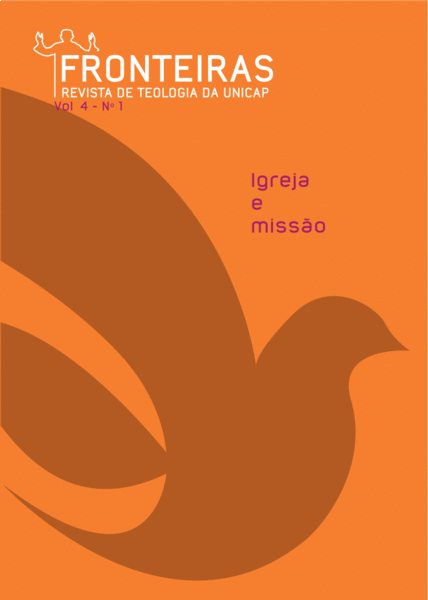The Asian Vision of Mission Today
DOI:
https://doi.org/10.25247/2595-3788.2021.v4n1.p105-127Palavras-chave:
Vision, Mission, Dialogue, Christianity, Colaboration.Resumo
Proclaiming the Good News of Jesus is the centrality of every Christian mission. This proclamation becomes dialogical through the integrating process of cosmic and metacosmic religions which facilitates the salvific divine-human encounter. The Church has come to realize this process only progressively. It is necessary to understand and to accept this process and this new vision, especially in the context of globalization, which has, increasingly, also a religious dimension. The Asian vision of mission seems relevant across the world as Hindu and Buddhist gurus make their ethical presence felt globally, particularly in Europe and North America. The ultimate goal of mission is the Kingdom of God and the Church as its symbol and servant. We recognize today that the Church is a co-pilgrim, together with other religions, who are fellow pilgrims towards this Kingdom. We are then called to dialogue and collaborate with people around the world. In this process, the Church is called to be in dialogue always with the poor, the cultures and the other religions.Downloads
Referências
AMALADOSS, M. A Call to Community: the Caste System and Christian Responsibility. Anand: Gujarat Sahitya Prakash, 1994.
AMALADOSS, M. Beyond Inculturation. Can the Many be One? Delhi: VIEWS/ISPCK, 1998.
AMALADOSS, M. El evangelio al encuentro de las culturas: Pluralidad y Communión de las Iglesias. Bilbao: Mensajero, 1998;
AMALADOSS, M. Life in Freedom: Liberation Theologies from Asia. Maryknoll N.Y.: Orbis, 1997. [Vivir en libertad. Estella: Editorial Verbo Divino, 2000.]
AMALADOSS, M. Missão e inculturação. São Paulo: Edições Loyola, 2000.
AMALADOSS, M. Quest for God: Doing Theology in India. Anand: Gujarat Sahitya Prakash, 2013.
AMALADOSS, M. The Asian Jesus. Maryknoll, NY: Orbis Press, 2006. [Jesús asiático. Bilbao: Mensajero, 2007.]
ANIMANANDA, B. The Blade: the Life and Work of Brahmababdab Upadhyaya. Calcutta: Roy and Son, 1947.
BATTUNG, M. R. et all. (eds.). Religion and Society: Towards a Theology of Struggle. Manila: Fides, 1988.
BOYD, R.H.S. An Introduction to Indian Christian Theology. Chennai: The
Christian Literature Society, 1969.
CATHOLIC BISHOPS’ CONFERENCE OF INDIA’S COMMISSION FOR DIALOGUE AND ECUMENISM. The Guidelines for Interreligious Dialogue. New Delhi: CBCI Centre, 1989.
CLEMENT OF ALEXANDRIA. Paedagogus: The Instructor. [s.l.] CreateSpace, 2015.
CLEMENT OF ALEXANDRIA. The Stromata or Miscellanies. [s.l.] Kessinger Publishing, LLC, 2004.
COMMISSION ON THEOLOGICAL CONCERNS OF THE CHRISTIAN CONFERENCE OF ASIA (ed.). Minjung Theology: Peoples as Subjects of History. Maryknoll, NY: Orbis Books, 1983.
COUNCIL VATICAN II. The Sexteen Documents of Vatican II. [s.l.] Pauline Books & Media, 1998
FARQUHAR,J. N. The Crown of Hinduism. London: Oxford University Press, 1913.
For All the Peoples of Asia, FABC Documents (1970-1991). Vol. 1. Manila: Claretian Publications, 1997.
FUELLENBACH, J. The Kingdom of God: the Message of Jesus Today. Maryknoll: Orbis Books, 2002.
GAUDENCIO, B. R; AREVALO, C.G. (eds), For All the Peoples of Asia, vol.I. Manila: Claretian Publications, 1997.
GNANAPIRAGASAM, J; WILFRED, F. (eds.). Being Church in Asia. Manila: Claretian Publications, 1994.
JOHANNS, P.Vers le Christ par le Vedanta. 2 vols. Louvain: Lessinaum, 1932-1933.
JOHN PAUL II. Redemptoris Missio. Roma, 1990.In: https://www.vatican.va/content/john-paul-ii/en/encyclicals/documents/hf_jp-ii_enc_07121990_redemptoris-missio.html
LE SAUX, H. Saccidananda: A Christian Approach to Advaitic Experience. Delhi: ISPCK, 1984.
LIPNER, J. Brahmobandab Upadhyay: The Life and Thought of a Revolutionary. Oxford: Oxford University Press, 1999.
MASSEY, J. Dalit Issues in Today’s Theological Debate. Delhi: ISPCK, 1994.
MONCHANIN, J. Mystique de l’Inde, mystère chrétien. Paris: Fayard, 1974.
MONCHANIN, J.; LE SAUX, HENRI. A Benedictine Ashram. Rev.Ed. Douglas: Times Press, 1964.
PHAN, P. C. (ed.). The Asian Synod. Texts and Commentaries. Maryknoll: Orbis Books, 2002.
PIERIS, A. An Asian Theology of Liberation. Maryknoll: Orbis, 1988.
POPE FRANCIS. Fratelli Tutti. Fraternity and Social Friendship. Roma, 3 October 2020. In: http://www.vatican.va/content/francesco/en/encyclicals/documents/papa-francesco_20201003_enciclica-fratelli-tutti.html
POPE FRANCIS; GRAND IMAM AHMAD AL-TAYYEB. Document on Human Fraternity for World Peace and Living Together. Abu Dhabi, 4 February 2019. In: http://www.vatican.va/content/francesco/en/travels/2019/outside/documents/papa-francesco_20190204_documento-fratellanza-umana.html
PRABHAKAR, M.E. (ed.). Towards a Dalit Theology. Delhi: ISPCK, 1989.
SAINT JUSTIN THE MARTYR. The First and Second Apologies. Hardcover: Paulist Press, 1997. (Ancient Christian Writers)
SOARES-PRABHU, George. The Kingdom of God: Jesus’ Vision of a New Society. In: AMALORPAVADASS, D.S. (ed), The Indian Church in the Struggle for a New Society. Bangalore: NBCLC, 1981.
THOMAS, M. M. The Acknowledged Christ of the Indian Renaissance. London: SCM Press, 1969.
ZAGO, M. Day of Prayer for Peace. In: Bulletin of the Secretariat for Non-Christian Religions 22, 1987, p.145-155.
Downloads
Publicado
Edição
Seção
Licença
Autores que publicam nesta revista concordam com os seguintes termos:
- Autores mantém os direitos autorais e concedem à Fronteiras - Revista de Teologia da Unicap o direito de primeira publicação, com o trabalho simultaneamente licenciado sob a Licença Creative Commons Attribution que permite o compartilhamento do trabalho com reconhecimento da autoria e publicação inicial nesta Revista.
- Autores têm autorização para assumir contratos adicionais separadamente, para distribuição não-exclusiva da versão do trabalho publicada nesta revista (ex.: publicar em repositório institucional ou como capítulo de livro), desde que reconheça e indique a autoria e a publicação inicial nesta Revista.
- Autores têm permissão e são estimulados a publicar e distribuir seu trabalho online (ex.: em repositórios institucionais ou na sua página pessoal) a qualquer momento depois da conclusão de todo processo editorial, já que isso pode gerar alterações produtivas, bem como aumentar o impacto e a citação do trabalho publicado (Veja O Efeito do Acesso Livre).























